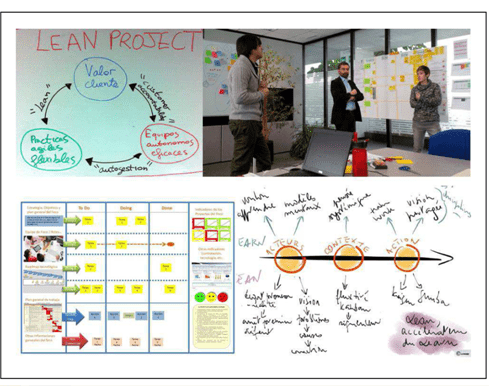It was organized by the Association for Organizational Learning SoL Spain (www.solspain.org). SoL Spain, is a community that share an interest in developing skills necessary for organizational learning to achieve fundamental changes in people and their organizations.
Persei Consulting, TECNALIA and CIDAUT share their business experiences in Lean Projects Management. Persei Consulting described their experience applying Scrum and agile methods in the management of software development projects, Tecnalia went into detail explaining the adaptation of these methodologies in their projects and pilot areas, and CIDAUT shared our experience deploying the Lean Project Management methodology.
Lean Project Management (LPM) is the application of Lean principles in the context of project management. LPM has many ideas in common with other lean concepts. The fundamental principle is based on creating more value with less «waste» using Lean tools such as standardization, visual control, daily Kaizen, etc.
The debate generated interesting conclusions for the companies got involved in a cultural change through the lean thinking and agile methods.
Start by enthusiasts
When an organization is facing a change, there are always three kinds of people: “Enthusiasts” (10%) who take easily the proposed changes, the “Silent majority” (80%) formed by neutral people who will adapt progressively to changes as they become consolidated and are extended, and finally “Reluctant to change” (10%) who tend to reject any proposal.
We agree that the best option is to start applying these methods in a pilot project with a good group of enthusiastic people involved. The following challenge is how to extend it to more people, more projects, and more departments. It is necessary to keep encouraging them and trust that enthusiasts will extend it to the rest.
Managers involvement, is it important?
Managers involvement is necessary to succeed in changing the management process?
We agree there are different degrees of involvement. The «laissez faire» management style to lead change as one priority. No one doubts that the rate of progress is higher when the Management is really involved.
But we agree that the degree of involvement or not is never an excuse for not promoting change initiatives from other non-hierarchical leadership when it takes sense to work according to this philosophy of work and applying agile methods.
Lean Tools
An advantage of the tools used in the application of agile methods is its simplicity.
Everybody learn how to use Lean tools without any problem. This can lead to the mistake of thinking that learning to use the tools, the change will occur by itself. This is not true but tools provide a way to initiate the change.
When we use the tools we need to adapt them to our type of work, to our reality, change tools conveniently and the real change occurs providing benefits when we change, when change the way we feel, the way we think and how we interact with our peers and customers.
Cultural change as main conclusion
As main conclusion we can say that the application of these methodologies is not an aim in itself, the ultimate goal is a change in the culture of our organization. Create a culture of collaboration and involvement of persons.
The change in the conditions a person does his job leads to a change of attitude in people. When people are involved they appreciate learning and action.
We agree that when an organisation improve working methods and workflow view, people change their attitude and that’s when the culture changes.
For more information about the content of this event visit the blog www.innpulsos.com
